|
|
20s | 30s | 40s | 50s | 60s | 70s | 80s | 90s | 2000s |
 |
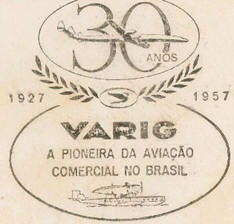
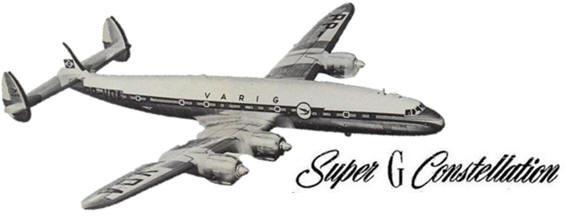
In 1952 VARIG bought Aero Gal, which enabled VARIG to expand its lines to Brazil's northeast, serving also Vitória, Salvador, Maceió, Recife, João Pessoa and Natal. In 1953 the line to Montevideo was expanded to Buenos Aires, VARIG's second international destination. The first flight took off on 30 June, on Rio de Janeiro - Sao Paulo - Porto Alegre - Montevideo - Buenos Aires route, operated with Curtiss C-46 three times a week. At that time the flight lasted about seven hours and ten minutes.
In 1953 VARIG made a complete restructure after received government permission to operate flights to the United States. VARIG ordered Convair 240 and four-engine Lockheed Super G Constellation. Convair 240 was the fastest aircraft at that time and would complement the flights made by Constellation. VARIG also created a sophisticated high quality on board and ground service.
On July 28, 1955 VARIG’s first flight to New York took off. Initially were two weekly flights that departed from Rio de Janeiro to New York, with stops in Belém, Port of Spain and Santo Domingo. The flight also proceeded to south, from Rio de Janeiro to Sao Paulo, Porto Alegre, Montevideo and Buenos Aires. With the flight to the USA, VARIG hired, for the first time, female flight attendant, as hitherto only men served in this role. Since Constellation had beds and was not appropriate women and children with pajamas be cared by men. The comfort and the on-board service offered by VARIG in Constellation were unparalleled and made the company internationally recognized for its quality. The Super G Constellation had 15 Tourist Class seats on the front of the plane: 5 rows, 3+2 seats. Two toilets behind, followed by 28 First Class seats arranged in four rows, 2+2. Then there was a living room with rotating seats. And then more 11 First Class seats. VARIG’s kitchen had cook from The Russian Royal Family and, for many people, VARIG’s food was better than any restaurant in Brazil.
To maintain its position as a pioneer and stay ahead of its competitors, VARIG ordered new Boeing 707 jet, in September 1957, and Caravelle jet in October. Brazil’s first jet aircraft arrived in September 1959, it was VARIG’s first Caravelle, immediately used on Rio – New York route. VARIG was the first airline in the world to operate a pure jet at JFK airport in New York. With Caravelle, the flight between Rio de Janeiro and New York was reduced from 25 hours to 14 hours. Nevertheless, Constellation still shared the route with Caravelle. The route was done twice a week with Constellation and twice a week with Caravelle, a total of four weekly frequencies.




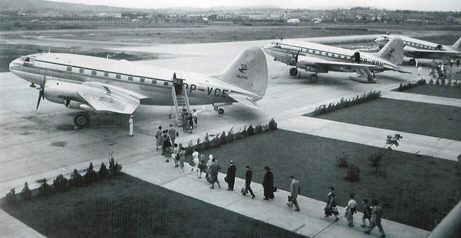
 |
|
Welcome aboard of VARIG's Super G Constellation The route between Rio de Janeiro and New York was originally granted to Cruzeiro, but the company eventually gave up and VARIG was then selected to operate it. To compete with Pan Am, VARIG knew it needed to choose the right aircraft. De Havilland Comet 1, Vickers Viscount, Bristol Britannia, Douglas DC-6 and DC-7 and Lockheed Super G Constellation, were analyzed. The Constellation was chosen for being versatile, with better operating balance "BEP", better range and load capacity.
The introduction of a complex, advanced and big size aircraft, generated a complete modernization in the company, with a complete on-board service review, new hangars, warehouses, workshops and even a new corporate image. The Constellation was the first aircraft to present the classic VARIG's blue-strip paint at window. In addition to the new look, VARIG prepared an on-board service that become a world reference. Luxury onboard VARIG's Super G Constellation included Thermidor lobsters, pheasants, foie gras, beluga caviar, Premier Crus Classes de Bordeaux and Champagne. All served by flight attendant in impeccable uniforms and makeup, silver cutlery, porcelain dinnerware and crystal glasses.
|
|
50s |
||
|
Fleet evolution:

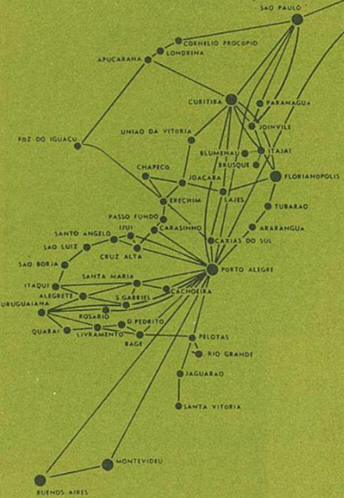


Regional, domestic and international route
map - 1956
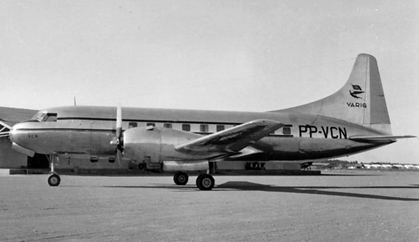
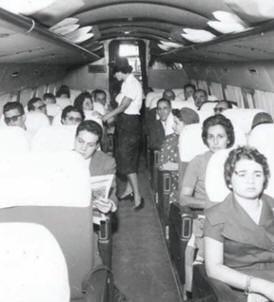

Convair 240 / Caravelle



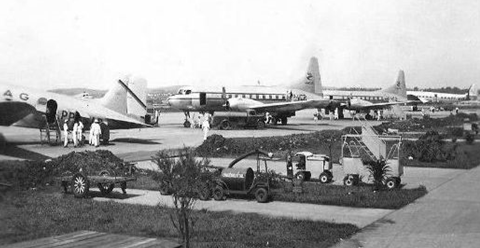


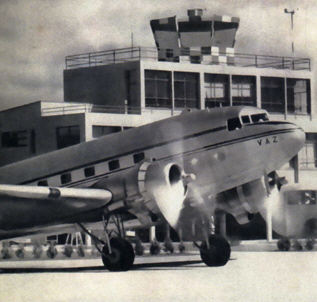


Porto Alegre Airport in the 1950's: Convair 240, DC-3 and
Lockheed Super G Constellation (Museu VARIG)
 |
|
IN FOCUS: Varig VS. Real
|




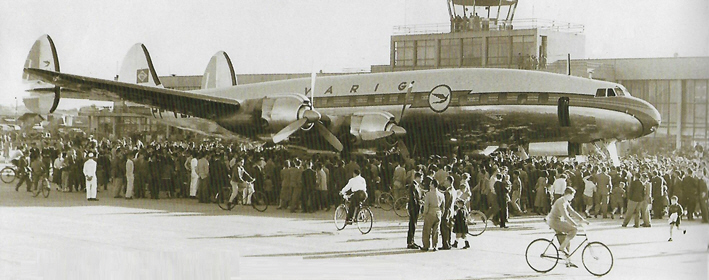

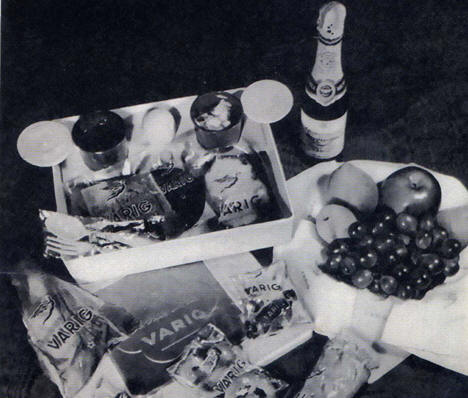

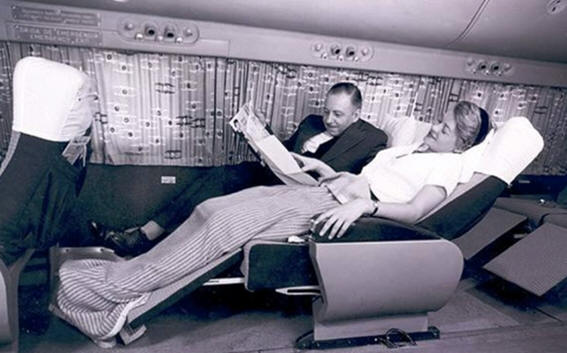








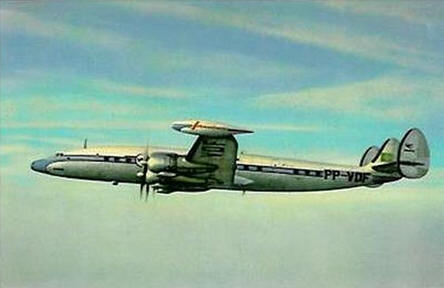 Since
July 1955 VARIG were focused on its more glamorous route
linking Rio de Janeiro to New York. But the company had
two main competitors: Pan Am and Real. Pan Am was simply
the largest and most powerful airline in the world and
to compete with her VARIG knew that it needed perfect
service on ground and on board. Real was newbie and
started international flights to Los Angeles and Miami,
after buy Aerovias. Real called passengers attention
with below average tariffs, but the dispute was best
remembered who had the most modern aircraft.
Since
July 1955 VARIG were focused on its more glamorous route
linking Rio de Janeiro to New York. But the company had
two main competitors: Pan Am and Real. Pan Am was simply
the largest and most powerful airline in the world and
to compete with her VARIG knew that it needed perfect
service on ground and on board. Real was newbie and
started international flights to Los Angeles and Miami,
after buy Aerovias. Real called passengers attention
with below average tariffs, but the dispute was best
remembered who had the most modern aircraft.